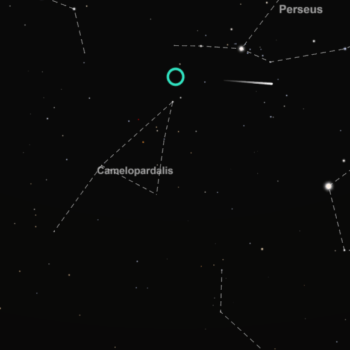August 2024 Sky
- Posted by OCastronomy
- On August 2, 2024
- 0 Comments
- Aldebaran, Antares, Beehive cluster M44, Castor, Jupiter, M35 star cluster, Mars, Mercury, Perseid meteor shower, Pleiades, Pollux, Regulus, Saturn, Spica, Uranus, Venus
August 2024 Sky
| 1 | Moon near M35 star cluster at 8h UT (morning sky). |
| 2 | Moon near Castor at 18h UT (morning sky). |
| 3 | Moon near Pollux at 0h UT (morning sky). |
| 4 | New Moon at 11:13 UT. Start of lunation 1257. |
| 4 | Mars 4.9° N of Aldebaran at 14h UT (morning sky). Mags. 0.9 and 0.9. |
| 5 | Venus 1.0° NNE of Regulus at 6h UT (17° from Sun, evening sky). Mags. −3.9 and 1.0. |
| 5 | Moon, Venus and Regulus within circle 2.7° diameter at 22h UT (17° from Sun, evening sky). Mags. −3.9 and 1.0. |
| 5 | Moon near Regulus at 23h UT (16° from Sun, evening sky). • Regulus (Wikipedia) |
| 6 | Moon near Venus at 0h UT (17° from Sun, evening sky). Mag. −3.9. Pairings of the crescent Moon and Venus always make for a spectacular sight. Don’t miss it! • Venus (Wikipedia) |
| 6 | Moon near Mercury at 7h UT (20° from Sun, evening sky). Mag. 1.7. An opportunity to view elusive Mercury. • Mercury (Wikipedia) |
| 7 | Mercury 5.7° SSW of Venus at 18h UT (18° from Sun, evening sky). Mags. 1.9 and −3.9. |
| 9 | Moon at apogee (farthest from Earth) at 2h UT (distance 405,297km; angular size 29.5′). |
| 10 | Moon near Spica at 9h UT (evening sky). Occultation visible from Eastern and SE Asia. • Spica (Wikipedia) • Occultation of Spica (In-The-Sky) |
| 12 | Perseid meteor shower peaks at 0h UT. Peak lasts about 12 hours. Active from July 14 to September 1. Produces swift, bright meteors (50-75 per hour) with persistent trains. Best viewed after midnight. • Perseids (Wikipedia) • 2023 Meteor Shower Calendar (PDF) |
| 12 | First Quarter Moon at 15:19 UT. |
| 14 | Moon near Antares at 3h UT (evening sky). Occultation visible from French Polynesia, Cook Islands and Pitcairn. • Antares (Wikipedia) • Occultation of Antares (In-The-Sky) |
| 14 | Mars 0.3° N of Jupiter at 16h UT (morning sky). Mags. 0.8 and −2.2. |
| 19 | Mercury at inferior conjunction with the Sun at 2h UT. The innermost planet passes into the morning sky. • Mercury (Wikipedia) |
| 19 | Full Moon at 18:27 UT. |
| 21 | Moon near Saturn at 1h UT (morning sky). Mag. 0.7. Occultation visible from Latin America, the Caribbean, Africa and Europe. • Saturn (Wikipedia) • Occultation of Saturn (In-The-Sky) |
| 21 | Moon at perigee (closest to Earth) at 5:10 UT (distance 360,196km; angular size 33.2′). |
| 25 | Moon near Uranus at 23h UT (morning sky). Mag. 5.7. • Uranus (Wikipedia) |
| 26 | Moon near the Pleiades at 4h UT (morning sky). • The Pleiades (Wikipedia) |
| 26 | Last Quarter Moon at 9:28 UT. |
| 27 | Moon near Jupiter at 12h UT (morning sky). Mag. −2.3. • Jupiter (Wikipedia) |
| 28 | Moon near Mars at 1h UT (morning sky). Mag. 0.8. • Mars (Wikipedia) |
| 28 | Moon near M35 star cluster at 14h UT (morning sky). |
| 30 | Moon near Castor at 0h UT (morning sky). |
| 30 | Moon near Pollux at 6h UT (morning sky). |
| 31 | Moon near Beehive cluster M44 at 9h UT (31° from Sun, morning sky). |
August 2024 Sky All times Universal Time (UT).
|
|


